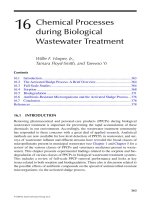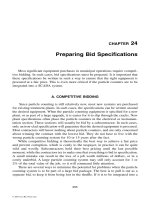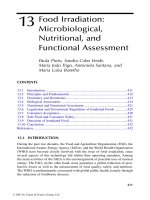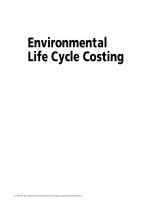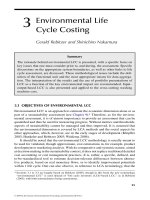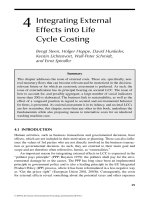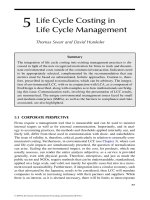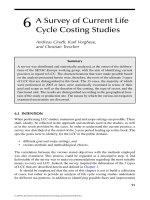Environmental Life Cycle Costing - Chapter 15 (end) pptx
Bạn đang xem bản rút gọn của tài liệu. Xem và tải ngay bản đầy đủ của tài liệu tại đây (1.45 MB, 21 trang )
219
CHAPTER
15
Environmental Cancer
15.1 INTRODUCTION
Cancer is any of a group of diseases characterized by uncontrolled growth and
spread of abnormal cells. The term “malignant neoplasm (tumor)” is often used in
place of cancer in the scientific or medical community. Most commonly, malignant
tumors develop in major organs, such as the lungs, liver, stomach, intestines, skin,
breasts, or pancreas, but they may also develop in lips, tongue, or the testes or
ovaries. Cancer may also develop in the blood cell-forming tissues of the bone
marrow (the
leukemias
) and in the lymphatic system or bones.
As noted earlier, cancer incidence and mortality have increased dramatically
over the last century. Researchers consider that there are two main reasons for this
increase: the aging of the population and an increase in pollution from carcinogens
present in and released into the environment through human activities. Indeed, nearly
30% of the total mortality in many industrialized countries is attributed to cancer.
In the U.S., cancer remains the number-two killer, accounting for nearly one fourth
of all deaths. Despite the recent decline in the mortality rate, the total number of
cancer deaths continues to rise as the elderly population increases. For example, in
the U.S. the toll in 1980 was 416,509; in 1995 it was 538,455;
1
and in 1999 it was
estimated to be 564,100.
2
One of the most common characteristics of the development of a neoplasm in
an organism is the long period of time between the initial application of a carcino-
genic (cancer-causing) agent, or carcinogen, and the appearance of a neoplasm. The
latency period varies with the type of carcinogen, its dosage, and certain character-
istics of the target cells within the host. In humans, cancer may not be manifested
until 10 or more years after an initial exposure to a particular carcinogen.
LA4154/frame/C15 Page 219 Thursday, May 18, 2000 12:05 PM
© 2001 by CRC Press LLC
220 ENVIRONMENTAL TOXICOLOGY
15.2 CAUSES OF CANCER
Many factors can lead to cancer. Table 15.1 gives an estimate of the contribution
of various agents or lifestyles to the cause of cancers. It is notable that diet and
smoking account for approximately two thirds of all cancers. Smoking is particularly
implicated in lung and bladder cancers.
Although there are many theories concerning the causes of cancer, the fundamental
idea underlying these theories is the alteration of the genetic material, the DNA of the
cell. The various theories attempt to explain how this change is brought about. The
DNA of a cancer cell is slightly different from that of a normal cell. This means that
the sequence of the bases — adenine (A), guanine (G), thymine (T), and cytosine (C)
— in a given strand of DNA is not the same as that of a normal cell. As discussed in
Chapter 14, these sequences dictate the sequence of the transcribed mRNA, which in
turn specifies the kinds of proteins to be synthesized in a cell. Alteration in the DNA
base sequence in cancer cells results in abnormal proteins. These new proteins influence
the mechanisms of growth control in such a way that cell division continues indefinitely.
15.3 STAGES IN THE DEVELOPMENT OF CANCER
Although the precise mechanisms involved in the causation of cancer are not
known, many researchers consider the pathway leading to
carcinogenesis
to include
three stages:
initiation
,
promotion
, and
progression
(Figure 15.1).
3
According to this
view, carcinogenesis is initiated following an alteration of the genetic information,
i.e., DNA of the cell. In other words, initiation occurs as a normal cell is transformed
into a precancerous cell via alteration of the DNA molecule, and reflects a permanent
and irreversible change in the initiated cell.
The stage of initiation can be altered by both endogenous and exogenous factors.
For example, a variety of chemicals in different tissues can inhibit the metabolism
Table 15.1 Speculative Proportion of Cancer Deaths Attributed
to Various Factors
Factor or Class of Factors Percent of All Cancer Deaths
Diet 35
Tobacco 30
Reproductive and sexual behavior 7
Occupational hazards 4
Geophysical factors 3
Alcohol 3
Pollution 2
Industrial products 1
Medicine and medical procedures 1
Infection 10?
Unknown ?
Adapted from USDHHS,
The Surgeon General’s Report on Nutrition
and Health,
U.S. Government Printing Office, Washington, DC, 1988.
LA4154/frame/C15 Page 220 Thursday, May 18, 2000 12:05 PM
© 2001 by CRC Press LLC
ENVIRONMENTAL CANCER 221
of a certain chemical to an
ultimate carcinogen,
thereby blocking the initiation
process. Furthermore, in humans there are corrective enzymes that can repair certain
damage and reverse the adverse effects (see Section 15.7). Initiators can also produce
transformed cells that may persist for the life-span of an individual without producing
cancer. In such cases, the damaged gene in the transformed cells remains recessive
because the damaged gene is not expressing an abnormal protein.
Promotion is the step involving gene activation to synthesize the abnormal pro-
tein. Thus, rapid cell division occurs, and this is accompanied by the interruption of
the organism’s normal function or health. Promotion then leads to the expression of
genetic changes as malignancy, which involves loss of control over cellular prolif-
eration. In contrast to initiation, promotion is considered to be reversible. Thus, if
the promoting agent is withdrawn well before tumors are manifested, the appearance
of tumors can be delayed or prevented. In addition, promotion may be continually
modulated by various environmental factors, including the frequency with which the
promoting agent is administered, age and sex of the experimental animals, hormonal
balance, and composition and amount of diet. Research shows that many promoting
agents exert their effects on the cell through mediation of receptor mechanisms.
4
Figure 15.1
Three stages of carcinogenesis. (Adapted from USDHHS,
The Surgeon General’s
Report on Nutrition and Health,
U.S. Government Printing Office, Washington,
DC, 1988.)
LA4154/frame/C15 Page 221 Thursday, May 18, 2000 12:05 PM
© 2001 by CRC Press LLC
222 ENVIRONMENTAL TOXICOLOGY
Some chemicals act as both initiators and promoters. Benzo[a]pyrene, a product
of incomplete combustion of carbonaceous material is such a chemical. In small
doses it initiates genetic damage, and in higher or repeated doses, a promotion
reaction ensues.
The agents involved in the onset of promotion cause cancer not by themselves
but only in an initiated cell. The artificial sweetener saccharin is an example of a
promoter. Promotion is gradual; moreover, some of the earlier steps are reversible.
In the promotion stage, abnormal proliferation of the affected cell occurs, presumably
because of a high concentration of growth factors or modified cell-surface receptors.
If the damage to the gene is not drastic, most of the normal components of the cell
will be produced and will be responsive to normal growth-inhibiting factors. Animal
experiments suggest that the time lapse between initiation and promotion is not
critical. During the later stage of promotion, however, cumulative genetic changes
occur, leading to totally irreversible neoplastic transformation.
Once a cell has been irreversibly modified, a cancer cell is born. It then multiplies
to produce a large number of cancer cells, forming tumors. In the third stage,
progression,
neoplasm progresses to a malignant/cancerous state. During this stage,
irreversible structural alterations occur in the genome of the neoplastic cell. These
are related to the increased growth rate, invasiveness, metastatic capability, and
biochemical changes in the malignant cell.
15.4 METASTASIS
The most fearsome aspect of cancer is the spread of malignant cells from the
primary site to other parts of the body, a process known as metastasis. Metastasis
is the primary reason for the failure of treatment in cancer patients. The extent of
the dissemination of the malignant cells is determined by the physiological condition
of the host. During metastasis continuous changes take place in the tumor, and the
function and behavior of the tumor cells in the late stage are quite different from
those in the early stage. The late stage of the disease is characterized by invasive
activity and the appearance of a variety of cancer cell types. Some of the cells, which
have the inherent ability to detach from the primary site, will eventually travel via
the blood or lymph to start a secondary tumor in another site. Most frequently the
location of metastasis is in the organ or organs that are served by blood vessels from
the original cancer site. It is noted that growth and survival of a tumor require
nourishment, which is provided by new blood vessels near the tumor site.
15.5 CLASSIFICATION OF CARCINOGENS
The basic changes in the DNA, i.e., mutation, can be caused by many agents.
These agents are generally classified into four categories: radiation, chemical, bio-
logical, and genetic (Table 15.2).
3
Although mutation does not necessarily result in
cancer, cancer occurs if the proteins that result from mutation affect cellular growth-
control mechanisms.
LA4154/frame/C15 Page 222 Thursday, May 18, 2000 12:05 PM
© 2001 by CRC Press LLC
ENVIRONMENTAL CANCER 223
15.5.1 Radiation
The process involved in radiation-induced DNA damage is complex and has
received much attention for many years. Ionizing radiation produces a wide variety
of DNA lesions, including a large number of base modifications, strand breaks, and
DNA-protein crosslinks.
5
It was mentioned in Chapter 14 that absorption of short-
wave UV radiation by DNA causes breakage in its strand, the opening of the rings
of its bases, and the formation of thymine dimers.
Ultraviolet radiation from sunlight is the main cause of skin cancer. Increased
UV radiation exposure — much of it caused by sunbathing or tanning under a UV
lamp — is the main contributing factor to skin cancer, whose incidence is rising
rapidly worldwide. Of the three types of UV radiation (UV-A, B, and C), UV-B
(
λ
= 280 to 320 nm) is the most harmful. UV-B is attenuated by Earth’s ozone layer.
Several other factors modulate the amount of UV radiation to which people are
exposed: time of day, season, humidity, and distance from the equator. Skin cancer
risk also depends on the skin type; fair skin that freckles or bumps easily is more
at risk than very dark-pigmented skin. People who live in sunny climates and have
red or blond hair and blue or light-colored eyes are at especially high risk. Among
the photochemical reactions that take place when UV-B penetrates the skin is muta-
tion of the DNA in skin cells. Humans have repair enzymes that can correct this
damage, but as the person ages, depending on the individual’s lifestyle, mutations
accumulate, and the repair system will eventually be overtaxed, resulting in skin
cancer. Researchers consider that the damage begins accumulating early — in
childhood; by young adulthood about 50% of one’s lifetime sunlight exposure may
have already accumulated.
15.5.2 Chemical Carcinogens
The association between exposure to chemicals and cancer incidence was first
reported in 1775 by the English physician Parcivall Pott, following the observation
of scrotal cancer in chimney sweeps.
6
With an increase in European industrial
development during the 19th century, high skin cancer rates were observed among
workers in the shale oil and coal tar industries. In 1915 a group of Japanese scientists
conducted experiments in which they painted rabbits with coal tar and induced
tumors. This has led to the knowledge that the compounds contained in coal tar can
produce cancer in animals. Several groups of organic compounds have now been
recognized as carcinogenic to experimental animals. These include polycyclic aro-
Table 15.2 General Classification of Carcinogenic Agents
Class Example
Radiations Ultraviolet and ionizing radiations
Chemical Polycyclic aromatic hydrocarbons, aromatic amines and
halides, benzene, vinyl chloride, aflatoxin B
1
, urethane,
asbestos, certain metals, diet, and tobacco smoke
Genetic Viruses
Biological Transgenesis by enhancer-promoter-oncogene constructs
LA4154/frame/C15 Page 223 Thursday, May 18, 2000 12:05 PM
© 2001 by CRC Press LLC
224 ENVIRONMENTAL TOXICOLOGY
matic hydrocarbons (PAHs), aromatic amines, aminoazo dyes, nitroso compounds,
benzene, vinyl chloride, and others.
7
In addition to industrial carcinogens, a variety of chemical agents found in food
can also cause cancer. For example, aflatoxin B
1
, which causes liver cancer in several
species of test animals, is produced by
Aspergillus flavus
found in contaminated peanut
or cottonseed meal. There are also naturally produced substances that are carcinogenic.
Various inorganic substances have also been shown to induce cancer. These
include certain salts of As, Be, Cd, Cr
6+
, Ni, and Pb, as mentioned previously
(Chapter 12). It is worth pointing out that some of the metals are essential nutrients
for humans and animals. Trivalent chromium (Cr
3+
) is one of these metals. As part
of the
glucose tolerance factor
, Cr plays an important role in maintaining normal
glucose metabolism in mammals.
Figure 15.2
Some examples of chemical carcinogens.
LA4154/frame/C15 Page 224 Thursday, May 18, 2000 12:05 PM
© 2001 by CRC Press LLC
ENVIRONMENTAL CANCER 225
In addition, several chlorinated hydrocarbons and other chemicals have been
identified as carcinogenic. They include 2,4-D, DDE, hexachlorocyclohexane, PCBs,
TCDD, and others.
15.6 METABOLISM OF CHEMICAL CARCINOGENS
As shown in Figure 15.1, chemical carcinogens are normally divided into two
broad classes: direct carcinogens and procarcinogens. Direct carcinogens are usually
electrophiles, such as H
+
, C
+
, N
+
, and they can react readily with nucleophiles, such
as proteins and nucleic acids. The main sites where such reactions can occur in these
molecules are S, =N–, –C–OH, or –P–OH. Examples of cellular nucleophiles include
some amino acids, such as methionine, cysteine, histidine, tryptophan, and tyrosine,
and nucleic acid bases, such as adenine (N-1; N-3) and guanine (C-8, N-7, O-6).
Procarcinogens, on the other hand, are those requiring biologic activation. In contrast
to direct carcinogens, procarcinogens are stable enough so that many people may
be exposed environmentally or occupationally. Therefore, it is possible for some
people to ingest or absorb some of the procarcinogens before enzymes in liver, lung,
or other organs convert them to their activated metabolites.
It is thought that most, and probably all, chemical carcinogens are, or are con-
verted by metabolism into, electrophilic reactants that exert their biological effects
by covalent interaction with DNA. Some examples of these reactants are shown in
Figure 15.2. In the following sections, several of these examples are discussed in
some detail. Our discussion will focus on free radicals, DDT, vinyl chloride, nitro-
samine, benzo[a]pyrene (BaP), and halogenated aromatic hydrocarbons.
15.6.1 Free Radicals
Certain free radicals, particularly oxygen free radicals, can damage nucleic acids,
altering their structures and function. Oxygen-induced lesions of nucleic acids include
strand breaks and base modification products. Superoxide has been shown to cause
DNA strand breaks.
8
On the other hand, the OH
·
free radical, formed through the
reaction between superoxide free radical (O
2
–
·
) and
H
2
O
2
(Equation 15.1), is unique
and has been shown to be capable of abstracting protons from DNA, causing breaks
O
2
–
·
+
H
2
O
2
→
O
2
+ HO
–
+ HO
·
(15.1)
in the phosphodiester bonds. Both single- and double-strand breaks can occur. In
addition, the free radical can abstract H atoms from the DNA helix.
9
15.6.2 DDT
DDT is one of the several pesticides that have been added to the long list of
cancer-causing agents in the environment. According to a report by the National
Cancer Institute, women with high exposures to DDT may have a greater risk of
contracting breast cancer. Researchers at Mt. Sinai Hospital in New York City have
LA4154/frame/C15 Page 225 Thursday, May 18, 2000 12:05 PM
© 2001 by CRC Press LLC
226 ENVIRONMENTAL TOXICOLOGY
found that women with blood levels of DDE of 19 ng/ml have four times the risk
of breast cancer as women with 2 ng/ml.
It is suggested that DDE, a stable metabolite of DDT (Chapter 13), may cause
breast cancer in two ways: (a) it may induce cytochrome P450 enzymes, thereby
altering the metabolism of toxicants; or (b) it may act as an estrogen mimic and, as
such, may disrupt the endocrine system through interaction with estrogen receptors.
15.6.3 Vinyl Chloride
Vinyl chloride (VC), the common name for monochloroethene (CH
2
=CHCl), is
one of the most manufactured organic chemicals in the United States. VC is a gas
at ambient temperature, with a boiling point of 14
°
C, and it exhibits a low solubility
in water. While the VC monomer itself is rarely used, it is polymerized with itself
and other organic compounds to form many products, thus making it a very important
chemical to industry and to consumers.
Among the many polymers that are derived from VC, polyvinyl chloride (PVC)
is the most common. PVC as a solid material is extremely adaptable and cost
effective, and is used in numerous construction materials, home furnishings, pack-
aging materials, automobile products, and others. Some examples of products made
of PVC are water pipes, raincoats, credit cards, wire coatings, and food packaging.
The process involving PVC production includes three stages: synthesis of VC
monomer from petrochemicals and chlorine; polymerization of VC into PVC resin;
and PVC fabrication. Environmental contamination occurs in these processes,
although the extent of the contamination varies with each stage. The contamination
includes emission of VC into the atmosphere, and surface and ground water con-
tamination resulting from sludge and wastewater discharge.
Vinyl chloride has been shown to be both mutagenic and carcinogenic. It is
classified as a Group 1 carcinogen because sufficient evidence exists that the com-
pound is carcinogenic to humans. This is highly important since only about 40
chemicals or chemical mixtures are classified as such.
10
Vinyl chloride causes liver
cancer in both humans and experimental animals. However, laboratory experiments
with mice showed induction of not only liver cancer but also cancers of bone, skin,
lung, brain, nephron, and mammary tissues.
10,11
In humans, the risk for VC exposure
may occur both occupationally and nonoccupationally.
Vinyl chloride is metabolized by the hepatic cytochrome P450 enzymes to the
carcinogenic epoxide form. Studies show that this metabolite is an ultimate carcin-
ogen, by reacting with DNA and causing the latter to change its function. In the
liver, the active epoxide may be further converted to chloroethane aldehyde. A
molecule of GSH can conjugate the aldehyde, and the resultant conjugate may then
be excreted (Figure 15.3).
15.6.4 Alkylating Agents
As noted in Chapter 14, alkylating agents are those chemicals that can react with
DNA to form alkylated DNA adducts. Several groups of organic compounds can be
metabolized to alkylating agents. An example is N-nitroso compounds that consist of
LA4154/frame/C15 Page 226 Thursday, May 18, 2000 12:05 PM
© 2001 by CRC Press LLC
ENVIRONMENTAL CANCER 227
nitrosamines and nitrosamides. Nitroso compounds are found in various types of food,
particularly meat and meat products (e.g., fried and cured meat products) and cheese.
Small amounts of the compounds have been shown to occur in beer. Tobacco smoke
also contains varying amounts of the compounds. Industrial exposure to N-nitro-
samines accounts for another environmental source. Occupation or industrial activities
that may potentially lead to exposure include metal cutting and rolling, leather tanning,
rubber manufacture, hydraulic fluids handling, and producing or using amines in the
chemical industry. In these activities, exposure is mostly via air and skin.
12
The importance of nitrosamines as environmental carcinogens was first postulated
in 1962. Subsequent studies demonstrated the endogenous formation of such com-
pounds from precursor amines and nitrite
in vivo
. The endogenous formation of N-
nitroso compounds from precursor amines and nitrosating agents, particularly nitrite,
is unique among the various chemical carcinogens. Nitrosatable amine precursors,
such as secondary and tertiary amines, are natural constituents of food or contaminants
of food, such as some pesticides that can be nitrosated. Nitrite is the most important
nitrosating agent and is present in some food products. However, nitrite can also be
formed from nitrate in saliva and possibly in intestine. The pathway leading to the
formation of an alkylating agent from dimethylamine is presented in Figure 15.4. The
first step is nitrosation, in which dimethylamine reacts with nitrite to form dimethyl-
nitrosamine, a nitroso compound. Metabolism of dimethylnitrosamine leads to the
formation of a CH
3
+
radical, which can react with DNA, resulting in methylated DNA.
Figure 15.3
Metabolism of vinyl chloride by cytochrome P450 system.
Figure 15.4
Activation mechanism of dimethylamine.
2
&\W3*6
+
& &+&O +
&&+&O&O¤&+
¤&+2*6¤&+
&+2
9LQ\OFKORULGH9LQ\OFKORULGH
HSR[LGH
+
&
+
&
1+
12
+
+
&
+
2
+2+
&
11 2
+
&
+
+
&
11 2+&+2
+
+
&1 12+
2+
+
2
+
& 1 1
+
&1
1
&+
1
'LPHWK\ODPLQH
'LPHWK\OQLWURVDPLQH
'LD]RPHWKDQH
$ON\ODWLQJ
DJHQW
+
&
11 2
+
LA4154/frame/C15 Page 227 Thursday, May 18, 2000 12:05 PM
© 2001 by CRC Press LLC
228 ENVIRONMENTAL TOXICOLOGY
15.6.5 Polycyclic Aromatic Hydrocarbons
Polycyclic aromatic hydrocarbons (PAHs) are a group of compounds composed
of two or more fused aromatic rings. They are emitted into the environment through
both natural and anthropogenic combustion processes. The two main sources of
natural PAH production are volcanic eruptions and forest fires. Anthropogenic
sources include fossil fuel combustion by automobiles and other transportation
systems, petroleum refining processes, coking plants, asphalt production, industrial
facilities that use fossil fuels, effluent disposal or oil spills, refuse burning, and
others. PAHs are, therefore, widely distributed in our environment — air, soil, water,
and sediment. They are of concern and represent major potential human hazards
because of their possible contamination of food and drinking water supplies. For
example, the carcinogenic PAH concentrations in various environmental media have
been estimated to be as follows: outdoor air (2.6 to 13.0 ng/m
3
), indoor air (1.5 to
13.0 ng/m
3
); surface water (8.0 ng/L); ground water (1.2 ng/L); drinking water (2.8
ng/L); rural soil (0.07 mg/kg dry wt.); urban soil (1.10 mg/kg); road dust (137
mg/kg); charcoal-broiled or smoked beef (35
µ
g/kg); pork (26
µ
g/kg); poultry (12
µ
g/kg); fish/shellfish (0.10
µ
g/kg); smoked fish/shellfish (36
µ
g/kg); green leafy
vegetables (46
µ
g/kg); grains (9
µ
g/kg); fruits (2.4
µ
g/kg); alcohol beverages (0.08
µ
g/kg); fluid milk (0.09
µ
g/kg); fats and oils (66
µ
g/kg); and cheese (1.70
µ
g/kg).
13
15.6.5.1 Benzo[a]pyrene
Among the many PAHs, benzo[a]pyrene (BaP) (Figure 15.5) is probably the
most widely known. Researchers have repeatedly shown the potent carcinogenic
effect of BaP since the British doctor P. Pott reported in 1775 the relationship
Figure 15.5
Formation of benzo[a]pyrene–guanine adduct.
0)2HQ]\PH
2
>2@
+
2+
2+
+
2
+
%D3
HSR[LGH
%D3GLRO
%D3GLRO
HSR[LGH
1
1
1+
2
1
1
+
*XDQLQH
+2
+
1
+2
+2
+
1
1
1
1+
2
5
%D3
+
+2
%D3JXDQLQHDGGXFW
+2
1
5
LA4154/frame/C15 Page 228 Thursday, May 18, 2000 12:05 PM
© 2001 by CRC Press LLC
ENVIRONMENTAL CANCER 229
between British chimney sweeps and the incidence of cancer of the scrotum. The
sources of BaP emission include coal refuse fires, residential furnaces, coke produc-
tion, vehicle disposal (open burning), wood burning, and forest and agricultural
refuse burning, among others. BaP is found in most commercial motor oil, asphalt
roofing and other construction materials, and tobacco smoke.
Like most PAHs, BaP is ubiquitous in the environment and is found in air, water,
soil, and food. According to Menzie et al.,
13
the BaP concentrations in 58 prepared
meals averaged 0.15
µ
g/kg, with a range of 0.005 to 1.17
µ
g/kg.
BaP can cause several forms of cancer, particularly cancers in the lung, intestine,
kidney, and liver. It has been reported that the ultimate carcinogenic form of BaP is
benzo(a)-7,8-diol-9,10-epoxide.
14
This active form of BaP is formed through cyto-
chrome P450-dependent activation followed by several enzymatic steps. The result-
ant BaP metabolite then forms an adduct with the base guanine in DNA, altering its
function. Figure 15.5 summarizes the activation process.
15.6.6 Halogenated Aromatic Hydrocarbons
Halogenated aromatic hydrocarbons, including polychlorinated dibenzodioxins
(PCDDs), polychlorinated dibenzofurans (PCDFs), and polychlorinated biphenyls
(PCBs) are toxicants of much public and scientific concern because of their wide-
spread distribution in the environment and the potential for human exposure from
numerous sources. As discussed in Chapter 13, examples of the sources include
combustion processes, contaminated pesticides, industrial accidents or uncontrolled
environmental discharge, and others. Humans may be potentially exposed to these
toxicants by such routes as (a) inhalation of vapors, aerosols, or respirable particles;
(b) ingestion of contaminated milk, meat, fish, water, and vegetation; and (c) dermal
absorption of contaminants in soil or from pesticides.
TCDD and some other halogenated aromatic hydrocarbons have been shown to
be carcinogenic in rats and mice.
15,16
Hepatocellular carcinomas were produced in
both species following TCDD exposure, but only female rats developed squamous
cell carcinomas of the lung, nasal turbinates, and hard palate.
16
Ingestion of 0.1
µ
g/kg per day in the diet resulted in an increased incidence of these tumors. In
addition to hepatocellular carcinomas, follicular cell adenomas of the thyroid were
significantly increased in male rats and female mice.
16
Other studies also reported a
dose-dependent decrease in tumors of estrogen-sensitive organs, including breast,
uterus, and pituitary.
17
This suggests that TCDD may be acting through a hormone-
like mechanism. Most evidence suggests that the carcinogenic activity of TCDD
results from a receptor-mediated, nongenotoxic, promotional mechanism.
18,19
PCBs are carcinogenic in rodents, producing hepatocellular carcinoma in rats
and hepatomas in mice.
19
The production of liver tumors in these species is related
to the degree of chlorination of the PCB mixture.
The halogenated aromatic hydrocarbons are believed to produce their toxic
effects through a common mechanism of action.
20
These compounds are able to
induce hepatic cytochrome P450 microsomal enzyme systems, especially aryl hydro-
carbon hydroxylase (AHH) activity. It is generally accepted that the toxic activity
of these chemicals is related to their interaction with a cellular receptor, the
Ah
LA4154/frame/C15 Page 229 Thursday, May 18, 2000 12:05 PM
© 2001 by CRC Press LLC
230 ENVIRONMENTAL TOXICOLOGY
receptor, which regulates the synthesis of a number of cellular proteins. The receptor
is an intracellular protein that binds to these biphenolic compounds based on stereo-
specific characteristics. Although the exact mechanism involved in the toxicity is
not known, it is thought that the toxicity results from interference with the control
of structural genes for several proteins through the binding of the
Ah
receptor (see
Figure 13.11).
15.7 DNA REPAIR
It is clear that DNA is damaged by a variety of chemical and physical agents.
Bases can be altered or lost, phosphodiester bonds in the backbone can be broken,
and strands can become covalently crosslinked. These lesions are produced by
ionizing radiation, UV light, and a variety of chemicals. It is important to note that
much of the damage sustained by DNA can be repaired because genetic information
is stored in both strands of the double helix, so that information lost by one strand
can be retrieved from the other.
21
In humans and animals, various systems exist that can repair a damaged DNA
molecule. Generally, four steps are identified in the repair process: (a) recognition
of the lesion by endonucleases; (b) removal of the damaged portion by exonuclease;
(c) replacement of the damaged section of DNA by polymerases; and (d) rejoining
the uninjured parts by ligases. The repair process is quite efficient, but errors may
occur. Some of these errors can be expressed as visible chromosomal abnormalities,
such as breaks, deletions, translocations, ring chromosomes, and sister chromatid
exchanges. It is considered likely that faulty DNA repair may lead to some mutations
and cancer.
15.8 REFERENCES AND SUGGESTED READINGS
1. National Center for Health Statistics, 1997.
2. American Cancer Society,
Cancer Facts & Figures
, 1999.
3. USDHHS,
The Surgeon General’s Report on Nutrition and Health
, U.S. Government
Printing Office, Washington, DC, 1988, 177.
4. Pitot, H.C. and Dragan, Y.L.P., Facts and theories concerning the mechanisms of
carcinogenesis,
FASEB J
., 5, 2280, 1991.
5. Le, X.C. et al., Inducible repair of thymine glycol detected by an ultrasensitive assay
for DNA damage,
Science
, 280, 1066, 1998.
6. Cole, P. and Goldman, M.B., Occupation, in
Persons at High Risk of Cancer. An
Approach to Cancer Etiology and Control,
Fraumeni, J.F., Jr., Ed., Academic Press,
New York, 1975, 167.
7. Pitot, H.C
Fundamentals of Oncology,
3rd ed., Marcel Dekker, New York, 1986.
8. Floyd, R.A., Role of oxygen free radicals in carcinogenesis and brain ischemia,
FASEB
J
., 4, 2587, 1990.
9. Cadenas, E., Biochemistry of oxygen toxicity,
Annu. Rev. Biochem
., 58, 79, 1989.
10. Van Duuren, B.L., Comparison of potency of human carcinogens: vinyl chloride
chloromethylmethyl ether and bis(chloromethyl) ether,
Environ. Res.,
49, 143, 1989.
LA4154/frame/C15 Page 230 Thursday, May 18, 2000 12:05 PM
© 2001 by CRC Press LLC
ENVIRONMENTAL CANCER 231
11. Moss, A.R., Occupational exposure and brain tumors,
J. Tox. Environ. Health
, 16,
703, 1985.
12. Preussmann, R., Eisenbrand, G., and Spiegelhalder, B., Occurrence and formation of
N-nitroso compounds in the environment and
in vivo
, in
Environmental Carcinogen-
esis
,
Emmelot, P. and Kriek, E., Eds., Elsevier/North-Holland Biomedical Press,
Amsterdam. 1979, 51.
13. Menzie, C.A., Potocki, B.B., and Santodonato, J., Exposure to carcinogenic PAHs in
the environment,
Environ. Sci. Toxicol
., 26, 1278, 1992.
14. Weinstein, I.B. et al., Benzo[a]pyrenediol epoxides as intermediates in nucleic acid
binding
in
vitro
and
in vivo
,
Science
, 9, 592, 1976.
15. National Toxicology Program (NTP),
Bioassay of 1,2,3,6,7,8- and 1,2,3,47,8,9-
Hexachlorodibenzo-p-dioxin for Possible Carcinogenicity, DHHS Publication (NIH)
80-1754, DHHS, Washington, DC, 1980.
16. National Toxicology Program (NTP), Bioassay of 2,3,7,8-Tetraclorodibenzo-p-dioxin
for Possible Carcinogenicity (Gavage Study), DHHS Publication (NIH) 82-1765,
DHHS, Washington, DC, 1982.
17. Kochiba, R.J. and Schwetz, B.A., Toxicity of 2,3,7,8-tetrachlorodibenzo-p-dioxin
(TCDD), Drug Metab. Rev., 13, 387, 1982.
18. Shu, H.P., Paustenbach, D.J., and Murray, F.J., A critical evaluation of the use of
mutagenesis, carcinogenesis, and tumor promotion data in a cancer risk assessment
of 2,3,7,8-tetraclorodibenzo-p-dioxin, Regul. Toxicol. Pharmacol., 7, 57, 1987.
19. Kimbrough, R.D. et al., Induction of liver tumors in Sherman strain female rats by
polychlorinated biphenyl Aroclor 1260, J. Natl. Cancer Inst., 55, 1453, 1975.
20. Poland, A. and Knutson, J.C., 2,3,7,8-Tetrachlorodibenzo-p-dioxin and related halo-
genated aromatic hydrocarbons: Examination of the mechanism of toxicity, Annu.
Rev. Pharmacol. Toxicol., 22, 517, 1982.
21. Stryer, L., Biochemistry, 3rd ed., W.H. Freeman & Co., New York, 1988, 694.
15.9 REVIEW QUESTIONS
1. What is cancer?
2. What are the two most important causes of cancer?
3. What are the three stages of carcinogenesis? Which of these is(are) considered
reversible?
4. What is the fundamental idea underlying the many theories about the causes
of cancer?
5. What is the main cause of skin cancer?
6. How does short-wave UV radiation affect DNA?
7. Which one is most harmful, UV-A, UV-B, or UV-C?
8. List five metals that can induce cancer.
9. What is metastasis? How does it occur?
10. What are procarcinogens?
11. In what way does superoxide free radical affect cancer?
12. How does vinyl chloride become a carcinogen?
13. What are nitroso compounds? Explain the way in which nitroso compounds
can induce carcinogenesis.
LA4154/frame/C15 Page 231 Thursday, May 18, 2000 12:05 PM
© 2001 by CRC Press LLC
232 ENVIRONMENTAL TOXICOLOGY
14. Explain how BaP can be converted into its ultimate carcinogen.
15. How may DDE be related to carcinogenesis?
16. Explain the suggested mechanism involved in dioxin acting as a carcinogen.
17. Explain the mechanism that humans or animals possess for repairing DNA
damage.
LA4154/frame/C15 Page 232 Thursday, May 18, 2000 12:05 PM
© 2001 by CRC Press LLC
233
Glossary
Abscission.
Process by which a leaf or other part is separated from the plant.
Acetylcholine (Ach).
Chemical transmitter of nerve and nerve–muscle impulses in
animals.
Acetylcholinesterase (AChE).
An enzyme of the body necessary for proper nerve
function that is inhibited or damaged by organophosphate or carbamate insec-
ticides taken into the body by any route.
Acute toxicity.
The toxicity of a material determined at the end of 24 h; to cause
injury or death from single dose or exposure.
Adsorption.
Chemical and/or physical attraction of a substance to a surface. Refers
to gases, dissolved substances, or liquids on the surface of solids or liquids.
Aerosol.
Colloidal suspension of solids or liquids in air.
Alkylating agent.
Highly active compounds that replace hydrogen atoms with alkyl
groups, usually in cells undergoing division.
Alumina.
Aluminum oxide, Al
2
O
3
.
Aminotransferase.
An enzyme that catalyzes transamination.
Anabolism.
Constructive metabolism — opposed to catabolism.
Aneuploidy.
Chromosomal changes that involve only single chromosomes within a
set.
Antagonism.
Decreased activity arising from the effect of one chemical or another
(opposite of synergism).
Anthropogenic.
Induced or altered by the presence and activities of humans.
Apoenzyme.
The protein without a prosthetic group (in an enzymatic system).
Arsenism.
A disease caused by arsenic poisoning.
Berylliosis.
Chronic beryllium disease.
Bilirubin.
A reddish yellow crystalline pigment occurring in bile, blood, urine, and
gallstones.
Biomagnification.
The increase in concentration of a pollutant in animals as related
to their position in a food chain, usually referring to the persistent, organochlo-
rine insecticides and their metabolites.
Biotransformation.
Metabolic conversion of a toxicant in the body.
LA4154/frame/GLOSS Page 233 Thursday, May 18, 2000 12:16 PM
© 2001 by CRC Press LLC
234 ENVIRONMENTAL TOXICOLOGY
Broad-spectrum insecticide.
Nonselective, having about the same toxicity to most
insects.
Bronchiolitis.
Chronic inflammation of the bronchioles.
Cachexia.
A general physical wasting and malnutrition caused by a chronic disease.
Calcination.
The action or process of calcining (heating under oxidizing conditions,
or converting to a powder by heating).
Carbamate insecticide.
One of a class of insecticides derived from carbamic acid.
Carcinogen.
A substance that causes cancer in animal tissue.
Carcinogenic.
Producing or tending to produce cancer.
Carcinogenesis.
The production of cancer.
Carrier.
An inert material that serves as a diluent or vehicle for the active ingredient
or toxicant.
Catabolism.
Destructive metabolism involving release of energy — opposite of
anabolism.
Chelating agent.
Certain organic chemicals (e.g., ethylenediaminetetraacetic acid,
EDTA) that combine with metal to form soluble chelates and prevent conversion
to insoluble compounds.
Chelation.
A process wherein atoms of a metal in solution are sequestered by ring-
shaped chemical species.
Chlorosis.
A disease condition of chlorophyll-bearing plants manifested as yellow-
ing or blanching of the normally green parts (leaves).
Chronic bronchitis.
Bronchitis is inflammation of the bronchi, resulting in a per-
sistent cough that produces considerable quantities of sputum. When such con-
dition persists over a long period and recurs over several years, it is referred to
as chronic bronchitis.
Chronic toxicity.
The toxicity of a material determined beyond 24 h and usually
after several weeks of exposure.
Ciliagenesis.
Production of cilia.
Cirrhosis.
A chronic progressive disease of the liver that is characterized by an
excessive formation of connective tissue followed by hardening.
Congenital.
Acquired during development in the uterus and not through heredity.
Cryolite.
Sodium aluminum fluoride (Na
3
AlF
6
).
Dealkylation.
The process of removing an alkyl group (from a compound).
Deamination.
The process of removing an amino group (from a compound).
Defoliant.
A chemical that initiates abscission (see abscission).
Demethylation.
Removal of methyl (from a compound, such as a DNA base).
Denaturation.
The process of denaturing — used especially for proteins.
Denature.
To deprive of natural qualities or characteristics.
Depurination.
Removal of a purine base.
Dermal toxicity.
Toxicity of a material as tested on the skin, usually on the shaved
belly of a rabbit; the property of a pesticide to poison an animal or human when
absorbed through the skin.
Detoxify.
To make an active ingredient in a pesticide or other poisonous chemical
harmless and incapable of being toxic to plants and animals.
LA4154/frame/GLOSS Page 234 Thursday, May 18, 2000 12:16 PM
© 2001 by CRC Press LLC
GLOSSARY 235
Diluent.
A diluting agent.
Dimerization.
Formation of a dimer (from two DNA bases, such as thymine).
Dose, dosage.
Same as rate. The amount of toxicant given or applied per unit of
plant, animal, or surface.
Dyspnea.
Shortness of breath.
EC
50
.
The median effective concentration (ppm or ppb) of the toxicant in the
environment (usually water) that produces a designated effect in 50% of the
test organisms exposed.
ED
50
.
The median effective dose, expressed as mg/kg of body weight, that produces
a designated effect in 50% of the test organisms exposed.
Edema.
An abnormal accumulation of serous fluid in connective tissue causing puffy
swelling.
Emaciation.
Wasted condition of the body.
Emphysema.
A condition of the lung marked by distention, progressive loss of
elasticity, and eventual rupture of the alveoli, and accompanied by labored
breathing and a husky cough.
Endocrine disrupter.
An exogenous agent capable of disrupting the normal function
of the endocrine system.
Endogenous.
Arising from internal structural or functional causes.
Epidemiology.
A science that deals with the incidence, distribution, and control of
disease in a population.
Epigastric pain.
Pain above the abdomen.
Erythrocytosis.
See polycythemia.
Estrogenicity.
Promotion of estrus.
Eucaryotic.
Having a visibly evident nucleus.
Euploidy.
A chromosomal change involving entire sets of chromosomes.
Exogenous.
Arising from outside.
Exostotic.
Having a bony outgrowth from a bone or the root of a tooth.
Extractant.
A solvent used for extracting organic compounds from plant or animal
tissues.
Fibrosis.
A condition characterized by deposition of excessive amounts of collagen.
Fluorapatite.
Calcium fluorophosphate, Ca
10
F
2
C(PO
4
)
6
.
Fluorosis.
An abnormal or poisoned condition caused by fluorine or its compounds.
Fluorspar.
Calcium fluoride, CaF
2
.
Food chain.
Sequence of species within a community, each member of which serves
as food for the next higher species in the chain.
Fumigant.
A volatile material that forms vapors that destroy insects, pathogens, and
other pests.
Fungicide.
A chemical that kills fungi.
Glucosuria.
Occurrence of glucose in the urine.
Glycogenolysis.
Breakdown of glycogen into glucose in the liver and muscle.
Hematopoiesis.
Formation of blood or of blood cells within the living body.
LA4154/frame/GLOSS Page 235 Thursday, May 18, 2000 12:16 PM
© 2001 by CRC Press LLC
236 ENVIRONMENTAL TOXICOLOGY
Hemolysis.
Liberation of hemoglobin from red blood cells.
Hepatoma.
A tumor of the liver that is usually malignant.
Holoenzyme.
Catalytically active complex of protein and prosthetic group.
Homeostasis.
A tendency toward maintenance of a relatively stable internal envi-
ronment in the bodies of higher animals (through a series of interacting phys-
iological processes).
Hormone.
A product of living cells that circulates in the animal or plant fluids and
that produces a specific effect on cell activity remote from its point of origin.
Hydrolysis.
Chemical process of breakdown or decomposition involving a splitting
of the molecule and addition of a water molecule.
Hyperostosis.
Excessive formation of bone tissue, especially in the skull.
Hyperplasia.
Abnormal increase in the number of cells of a tissue.
Hypertrophy.
Abnormal increase in the size of cells of a tissue.
Hyperuricemia.
Increase in the uric acid concentrations in blood.
Hypoplasia.
A thin enamel.
Hypoproteinemia.
Low protein levels in blood.
Hypoxia.
A deficiency of oxygen reaching the tissues of the body.
Inhalation.
Exposure of test animals either to vapor or dust for a predetermined time.
Intragenic deletion.
An extensive deletion of a gene so that the information carried
by that gene is essentially lost.
Invertase.
The enzyme that breaks down sucrose into glucose and fructose.
Isoenzymes
(or isozymes). Enzymes that catalyze the same reaction but migrate
differently on electrophoresis.
Itai-itai-byo.
Ouch-ouch-disease, caused by cadmium poisoning.
LC
50
.
The median lethal concentration, the concentration that kills 50% of the test
organisms, expressed as mg or ml (if liquid) per animal. It is also the concen-
tration expressed as parts per million (ppm) or parts per billion (ppb) in the
environment (usually water) that kills 50% of the test organisms exposed.
LD
50
.
A lethal dose for 50% of the test organisms. The dose of toxicant producing
50% mortality in a population. A value used in presenting mammalian toxicity,
usually oral toxicity, expressed as mg of toxicant per kg of body weight (mg/kg).
Lacrimation.
Secretion of tears.
Leachate.
The liquid that has percolated through soil or other medium.
Leukocytosis.
An increase in the number of leukocytes in the circulating blood.
Lipolysis.
Breakdown of fats.
Lipophilicity.
Having strong affinity for fats.
Lumina.
Plural form of lumen, the cavity or passageway of a tubular organ.
Lysis.
A process of disintegration or dissolution.
Lysozyme.
A basic protein that is present in egg white and in biological secretions
and that functions as a mucolytic enzyme and is capable of attacking the capsules
of various bacteria.
Mercurial.
A chemical compound that contains mercury.
LA4154/frame/GLOSS Page 236 Thursday, May 18, 2000 12:16 PM
© 2001 by CRC Press LLC
GLOSSARY 237
Mesocosm.
A larger microcosm; usually, but not always, involves more trophic
levels and generally a greater complexity than a microcosm toxicity test.
Metabolism.
The sum of all chemical reactions that occur within a living cell.
Metallothionein. Low-molecular-weight, nonenzymatic proteins with unique amino
acid composition.
Metastasis. Spread of malignant cells from the primary site of a cancer to other
sites of the body.
Methemoglobin. A soluble, brown, crystalline, basic pigment that is formed from
blood, hemoglobin, or oxyhemoglobin by oxidation.
Microcephaly. A condition of unusual smallness of the head, usually associated
with mental defects.
Microcosm. A type of multispecies toxicity test; also called small cosmos toxicity test.
Microphthalmia. Abnormal smallness of the eye.
Morbidity. The incidence of disease.
Morphogenesis. The formation and differentiation of tissues or organs.
Mutagen. An agent that tends to increase the occurrence or extent of mutation.
Myopathy. Disorder of muscle tissue or muscles.
Necrosis. Death of tissue, plant or animal.
Neoplasm. A new growth of animal or plant tissue more or less resembling the
tissue from which it arises, but serving no physiologic function, and being
benign or potentially malignant.
Nephrosis. Noninflammatory degeneration of the kidneys, chiefly affecting the
tubules.
Nephrotoxin. A toxicant that can poison the kidney.
Nitrosation. The process of converting into a nitroso compound.
Oncogenic. The property to produce tumors (not necessarily cancerous) in tissues.
Organochlorine insecticide. One of the many chlorinated insecticides, e.g., DDT,
dieldrin, BHC, chlordane, etc.
Organophosphate. Class of insecticides (also one or two herbicides and fungicides)
derived from phosphoric acid esters.
Osteomalacia. A disease of the bones characterized by softening, affecting adults
of man and domestic animals.
Paraesthesia. An abnormal sensation, as prickling, itching, etc.
Pathogen. Any disease-producing organism or virus.
Peroxidation. The process of forming a peroxide.
Persistence (for an insecticide). The quality of an insecticide to persist as an effective
residue due to its low volatility and chemical stability, e.g., certain organochlo-
rine insecticides.
Pesticide. An “economic poison” defined in most state and federal laws as any
substance used for controlling, preventing, destroying, repelling, or mitigating
any pest. Includes fungicides, herbicides, insecticides, nematicides, rodenti-
cides, defoliants, etc.
LA4154/frame/GLOSS Page 237 Thursday, May 18, 2000 12:16 PM
© 2001 by CRC Press LLC
238 ENVIRONMENTAL TOXICOLOGY
Pharyngitis. Inflammation of the pharynx.
Phytochelatin. A class of sulfur-rich polypeptides that occur in plants and can form
a complex and thus neutralize a toxic metal such as cadmium.
Phytotoxic. Injurious to plants.
Pica. A craving for and eating of unnatural substances.
Pneumonitis. A disease characterized by inflammation of the lungs.
Pneumo(no)coniosis. A disease of the lung caused by habitual inhalation of irritant
mineral or metallic particles.
Point mutation. A kind of mutation involving displacement of a nucleic acid base
with another or insertion or deletion of a nucleoside within a polynucleotide
sequence of a gene.
Polycythemia. A condition marked by an abnormal increase in the number of
circulating red blood cells.
Polymorphism. Capability of assuming different forms.
Potentiation. The action or process of causing an increase in physiological activity.
Procarcinogen. A carcinogen that requires biologic activation.
Proliferation. Rapid and repeated production of new parts or of buds or offspring.
Proteinuria. Occurrence of proteins in the urine.
Pyrolysis. Chemical decomposition or other chemical change brought about by the
action of heat regardless of the temperature involved.
Remediation. The act or process of remedying; usually referring to an application
that serves to restore the health of an affected or a contaminated site.
Resistance (insecticide). Natural or genetic ability of an organism to tolerate the
poisonous effects of a toxicant.
Rodenticide. Pesticide applied as a bait, dust, or fumigant to destroy or repel rodents
and other animals, such as moles and rabbits.
Silicatosis. A disease caused by habitual inhalation of silicates.
Silicosis. A disease caused by habitual inhalation of silica.
Sinusitis. Inflammation of the sinuses.
Splenomegaly. Enlargement of the spleen.
Sural. Relating to branches of the popliteral artery or vein that ramify in the calf
of the leg.
Synergism. Increased activity resulting from the effect of one chemical on another.
Systemic. Compound that is absorbed and translocated throughout the plant or
animal.
Target. The plants, animals, structures, areas, or pests to be treated with a pesticide
application; or the plant/animal structure or organ where a toxicant exerts its
toxic action.
Teratogen. An agent that causes teratogenesis.
Teratogenesis. Production of monstrous growths or fetuses.
Teratogenic. Relating to teratogenesis.
Thyroxine. A crystalline iodine-containing substance that is the chief active principle
of the thyroid gland.
LA4154/frame/GLOSS Page 238 Thursday, May 18, 2000 12:16 PM
© 2001 by CRC Press LLC
GLOSSARY 239
TLV. Threshold Limit Value.
TLV–TWA. Time-weighted average threshold limit value. The maximum time-
weighted average concentration to which a healthy worker may be exposed for
a normal 40-h work week up to 8 h a day over a working lifetime (40 to 50
years), without becoming ill.
Tolerance. Amount of toxicant/pesticide residue permitted by federal regulation to
remain on or in a crop (expressed as ppm).
Tolerant. Capable of withstanding effects.
Toxicant. A poisonous substance such as the active ingredient in pesticide formu-
lations that can injure or kill plants, animals, or microorganisms.
Toxin. A naturally occurring poison produced by plants, animals, or microorganisms;
for example, the poison produced by the black widow spider, the venom pro-
duced by snakes, and the botulism toxin.
Tracheobronchitis. Inflammation of the trachea and bronchi.
Vesicle. A plant or animal structure having the general form of a membranous cavity.
Xenobiotics. Toxicants found in the environment.
LA4154/frame/GLOSS Page 239 Thursday, May 18, 2000 12:16 PM
© 2001 by CRC Press LLC
